![Review Of The Perfect Fit Harness]()
by Lisa | Dec 8, 2015 | Reviews, Training Methods

First time Jaime wore a Perfect Fit Harness.
I had the opportunity to try out Sally Hopkins’ Perfect Fit Harness and I really like it. Here are my first impressions:
Vibrant Colours
I just love the wide range of colours that the top piece comes in. My favourite is the purple, but they have so many rich, vibrant colours to choose from – black, blue, brown, green, pink, purple, red, blue, wine, black reflective, high vis yellow, high vis orange and black fleece with rainbow webbing. The front and girth pieces are only available in black webbing and fleece.
Soft Yet Strong
The fleece is just so soft and comfortable that it makes me want to just rest it against my face. But even though the fleece is soft, it is very strong and durable. The fleece reduces rubbing and pressure points. The nylon webbing is strong too.
Adaptable Sizing

Perfect Fit Harness pieces
The Perfect Fit Harness comes in three pieces. The front is Y shaped and goes around the dog’s neck with the tail piece of the Y going between the dog’s front legs. It has black webbing stitched on to black fleece with the D-ring front attachment. The top piece has the webbing stitched on to the coloured fleece along with a D-ring attachment at the back. The girth piece also has black webbing where the D-ring is reinforced. This D-ring on the girth piece is where the tail end of the Y-front piece is attached.
Having three individual pieces – front, top and girth piece – is great because as your puppy grows, or if it is damaged, you just buy the piece(s) that you need instead of buying a whole harness.
Sturdy & Well Made
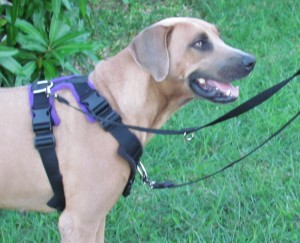
Jaime posing in the Perfect Fit Harness
This harness is extremely well made – the stitching is neat, the three metal D-rings are smooth and strong, and the plastic adjustable clips are sturdy.
Sizes
There is a wide range of sizes to choose from. It ranges in size from tiny, which could fit a 4 month old Chihuahua or cats, to extra large, which is made for huge Mastiffs or even large pigs. The girth and front pieces have five points of adjustment to make the front and girth pieces smaller or larger. The D-rings and clips come in a variety of sizes too from small 15mm to extra large 40mm.
Easy to put on
Phew, what a relief! Harnesses come in different styles and are for the most part a pain to figure out how to put on. I found the Perfect Fit Harness to be easy. Attach the front and top pieces together, attach the girth to the front, put the back and front piece over your dog’s head, slip the girth piece under your dog’s chest, between his leg and then just clip the snaps of girth to the top piece. Voila!
How it works
You need a double ended clip leash to attach to the front and top D rings, to help with steering. I also found it easy to control the dog and it helps prevent pulling. You should not have the leash tight at both ends.

Jaime got used to the Perfect Fit Harness quickly and easily.
Tripods
An added bonus to this harness is that it can be adjusted and used for dogs who have had a front leg amputated. There is a video on the website to see how to choose.
Website
The Perfect Fit Harness website is full of useful information from the colour choices, sizing, and a Breed Chart Guideline with lots of videos too.
http://www.dog-games-shop.co.uk/perfect-fit-fleece-dog-harness.html
I have to admit, this is my new favourite harness!
![Review Of The Perfect Fit Harness]()
by Lisa | Nov 17, 2015 | Events, Training Methods
No, not the dog. The Border Collies I’m talking about are people who volunteer to help at the Association of Professional Dog Trainers’ Annual Educational Conference & Trade Show. They are integral to the smooth and successful running of these Conferences.
2015 APDT Conference Border Collie Volunteers
They assist in rounding up and herding folks to the right sessions, assisting during demos, checking names tags at the door, answering questions, showing people to their seats, and helping during breaks.
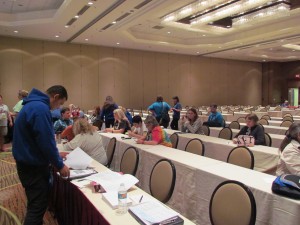
The start of the BC Orientation Meeting with Carlos Betancourt, a co-host, on the far left standing, standing reading his notes
Being a member of the Border Collie Brigade provides you with the opportunity to meet new and interesting people, form new friendships, and enjoy the satisfaction of a job well done.
Bill Hatherley, the Border Collie Lead on the APDT Task Force says – “We like to say it is our privilege to help the attendees have a great conference experience. While it may not be noticeable, a lot of oversight and management was done in the months leading up to the Conference. Irma Bice, Neil Smith and I had been planning for and working on this conference since March of last year. We met every two weeks via conference call and coordinated our efforts.”
This year, there were 42 volunteers, with 19 of them being veterans who have been Border Collies for 10 years – now THAT is dedication! We even had some BCs take on 6 assignments. Wow!!!
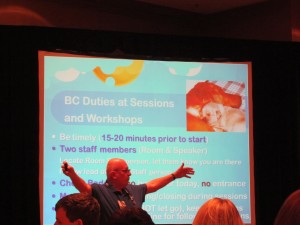
Bill Hatherley, BC Lead, giving the Duties of the BCs
The rest were at their first conference and wanted the opportunity to help and to network. We worked hard at providing them opportunities to meet new folks and everyone I talked to was very happy with this.”
Bill is very much like a cheerleader, he and Carlos Betancourt hosted the Training Meeting of the Border Collie Brigade. Between the two of them, they got the BCs excited and enthusiastic about their role. This great attitude carried on throughout the conference, helping all attendees to enjoy it even more.
I so wanted to be a BC, but my duties of reporting and blogging for The Modern dog Trainer took precedence. I chatted with some Border Collies – Jolynn Payne, Theresa Hyatt Cahill and Ryan Lockard and asked them some questions about their experiences.
1. Was this your first time being a BC?
- Jolynn – “It was my first year.
- Theresa – “First time.”
- Ryan – “This was my first time as a BC.”
2. Why did you volunteer as a BC?
- Jolynn – “I was at the conference a day early so I wanted to help and get involved.”
- Theresa – “Thought I’d get a better understanding and learning from other trainers. I did.”
- Ryan – “I volunteered because I like being involved and helping.”
3. Will you volunteer to be a BC again?
- Jolynn – “Absolutely!”
- Theresa – “YES I would volunteer again.”
- Ryan – “I would volunteer again.”
4. What was your best experience of the Conference?
- Jolynn – “Meeting new friends!”
- Theresa – “Best I found was that there was a lot of help getting started. A lot of helpful info and useful info building my business”
- Ryan – “The best thing was the positive comments that I received from the conference staff and the people I got to meet.”
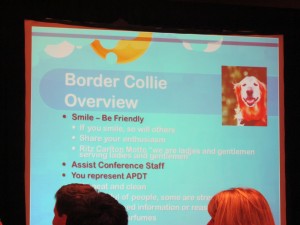
5. What was the worst experience you had being a BC?
- Jolynn – “Having to BC in a session where the speaker kept repeating “ok” after every sentence. Stopped counting after 35 in the first 30 minutes.”
- Theresa – “There wasn’t enough communication. I met a few trainers but other than that I was on my own to find info – who and how to contact someone if you were available for other things, where to go if I had a comment or complaint. The ones that have been there before welcomed me but I had so much free time and I didn’t know where to turn to offer any help if someone needed it. But everything worked out because now I know who to look for and where (for the most part) to go if I don’t.”
- Ryan – “The worst thing was the bag stuffing; it seemed to be very unorganized.”
6. What the duties did you volunteer to do?
- Jolynn – “I worked the check-in shirt table and 2 different sessions checking badges and watching doors.”
- Theresa – “I greeted and directed attendees”
- Ryan – “My duties were to verify attendees had paid for the day, that they were eligible to attend the workshop and to do the necessary head counts.”
Bill Hatherley, the BC Lead welcomes constructive comments and got lots of feedback from the volunteers, all to make things better and more efficient in the following years.
The BCs got special buttons, a BC ribbon on their lanyard, and a free APDT Conference shirt if they volunteered for 3 or more sessions. They also were invited to a yummy breakfast especially for them.
The next APDT Conference will be in 2016 Conference in Las Vegas. Consider sharing a few hours of your trip to help out as a volunteer Border Collie! Their contribution is invaluable and greatly appreciated.
Dog Training Business Tips
Receive valuable dog training business tips and resources right in your inbox! Subscribe to The Modern Dog Trainer now by submitting your name and email below. Don’t forget to let us know what you want to learn more about!
[mc4wp_form]
![Review Of The Perfect Fit Harness]()
by Lisa | Nov 11, 2015 | Events, Training Methods
As a first time attendee of the 2015 APDT Annual Educational Conference & Trade Show, I was known as a “Conference Puppy” and I was thrilled to bits to travel all the way from Barbados to Dallas, Texas, USA to gain knowledge about dog training, behaviour and the business aspect of the dog industry.
Another important part of this conference, for me, was the networking. It was wonderful to meet my Facebook friends – Casey Lomonaco and Robin Bennett of the APDT’s Board of Trustees; guests I had on my Chat Time Interviews – Roger Abrantes, Michael Shikashio, Grisha Stewart and Josh Pitts; my Texan friends Abby Merlot, Jolynn Payne, Kevin Glowski, and my roommates Cheri Spaulding and Karen Reilly and so many others. Greater bonds of friendship have been made by spending our free time together and I truly value meeting them in real life.

Part of the gang networking at the Draft Lounge Catherine Steinke, Jolynn Payne, Carlos Betancourt in front, Cheri Spaulding, Kevin Glowski, Lisa White at the back.
The Sheraton Dallas Hotel, located in downtown Dallas, was huge, with lots of walking to get around. It was beautiful and the staff very friendly and helpful. The food was good and I ate from a variety – Peets was great to grab yummy Starbucks coffee (loved the Pumpkin Spice Latte) and a quick bite; I had the buffet breakfast at the Kitchen Table Restaurant, which had such a variety to choose. Most of the socialising was done at the Draft Media Sports Lounge. It was the perfect atmosphere with great music but you could still have a conversation, watch sports on their large screen TV’s, or play pool.
I found the schedule of things to do and see to be completely filled each day. The APDT even had an early meetup – AM Riser, Get to know your Neighbourhood Walk, from 7 – 7.45am. Errm I like my bed so that was too early for me and I didn’t make those meets. LOL.

Dr Stephen Ledoux and I
On Wednesday, day 1, the keynote speaker was Dr. Stephen Ledoux. He gave a talk about, “Helping Our Canine Friends By Helping Ourselves With Science.”
Each day from 8am to 5pm, there were the Live Animal Workshops. You could also choose the General Sessions which consisted of four Shorts to choose from, where speakers talked on a variety of topics for 45 minutes. They ran from 8 to 8.45, 9 to 10.30, and 10.45 to 12.15.
Lunch was an hour and a half, but even during lunch there were roundtable discussions and demos of freestyle, Hollywood dog or you could browse the vendors at the trade show.
The presentations started back from 1.30 to 3pm and again at 3.15 to 4.45pm. Thankfully there were breaks of 15 minutes to get to the other presentations and stretch your legs.
Even after the speakers presentations, there was still something to see and do from 5 to 9.30pm – Toy Making, Scientific Poster Session, more doggy demos and on Friday night was the APDT Foundation Reception and Auction which was great.
There were 3 tables full of mostly doggie items to bid on, ranging from dog toys, collars, personal sessions with Roger Abrantes and Sue Steinberg to name a few, as well as trips to the Caribbean. There were hors d’oeuvres and music, to which I danced a lot and managed to get the DJ to play some good modern pop music.
On the last day, Saturday, I was very sad, knowing this was the last day I would see my friends for another year and I was all teary eyed. Roger Abrantes gave a wonderful closing talk on, “Animal Training My Way,” which touched on our relationship with animals – bonds and respect.
“All we need do is control ourselves, our thoughts, our emotions and our behavior. If we do it correctly, we will produce the changes in others that exist, not against their will, not by force or manipulation of the truth, but because they want they want it.” – Roger Abrantes
If I had to choose who was the best speaker, it would be extremely difficult. A lot of interesting information was shared, some I already knew a bit about, so it was good to get it explained further and I also learnt new things.
However, where I think I truly benefited was in the business topics, since we dog trainers tend to want to learn everything we can about dogs, but neglect the business/marketing side of things.

Veronica Boutelle, myself and Gina Phairas of Dogtec. They are really nice folks.
My favourite speakers were the Dogtec duo – Veronica Boutelle and Gina Phairas, who had a variety of presentations – Newsletter Marketing, Start Your Business On the Right Paw, Put More $ In Your Pocket, and more. It was great to meet them and they are as nice in person as they were to deal with, when I was so fortunate to have won the APDT 2013 Business Makeover.
Overall, I found everyone to be friendly, even the Ph.D’s, those brainy folks, were nice and humble. They didn’t talk down to you at all and the “famous” folks, the big names who have written books or put out DVDs, were quite welcoming. I didn’t encounter any snobs there at all, no one thought they were better than others. It truly was a great atmosphere.
Oh, here are some tips for those attending conferences that I learnt the hard way –
1. Wear warm clothes, as it seems the powers that be like to keep you cold which apparently keeps you alert. I just shiver and quake.
2. Don’t overpack. Most people wear the same clothes from morning till night and it’s usually casual – jeans, shirt, sweater. Less clothes, means more room for dog books and toys. Oh and take a portable scale for your luggage; you don’t want to be overweight from all the goodies you buy and pay extra for your luggage.
3. Wear comfortable shoes since you will be walking all over the hotel, with warm thick socks. I made the mistake of wearing boots with heels the first day and my feet hurt from all the walking I was doing. Lesson learnt. I then wore my fluorescent orange sneakers everywhere. A friend said, “if you cannot find Lisa, just look down at the shoes.”
4. Have extra batteries and/or chargers. In one day my camera, cell and laptop died, grrrrrrr.
5. If allowed, take lots of pictures instead of writing notes from the Powerpoint Slides, you will always miss something. And put your camera on silent, so as to not disturb others.
6. Be organized. Know which speakers you want to see and print out the daily schedule in advance, so you are organized. Most hotel rooms don’t have free wifi, so you won’t be able to access the website.
7. If the Conference has an app, download it. This is very useful, since it has all the info about the Conference on it.
8. If you are traveling from another country, like me, phone calls and texts will be charged at an international rate, so it will be expensive. If possible, buy a SIM card with data. You can get one at the airport, but it would be cheaper from a local store.
9. Know where the Speakers will be located and how to get there. You will probably still get lost (I did, many times), but you can always ask others and follow them.
10. Get out there and talk to people; no sense in being a wallflower. Conferences are a great opportunity for networking, to meet new people, to exchange ideas, to make contacts with people in the industry. And DO remember to bring business cards and exchange them with other people.
With such a great experience at the APDT 2015 Conference, will I be attending future Conferences? HECK YEAH!! I am already planning on going to next year’s conference in Las Vegas.
Hope to see you there!
Dog Training Business Tips
Receive valuable dog training business tips and resources right in your inbox! Subscribe to The Modern Dog Trainer now by submitting your name and email below. Don’t forget to let us know what you want to learn more about!
[mc4wp_form]
![Review Of The Perfect Fit Harness]()
by Lisa | Oct 16, 2015 | Events
Before I get into today’s Speakers, I just want to report on what a great Conference this is! Everyone is so nice and friendly, I am rooming with Facebook friends, met lots of other friends as well as people I have interviewed. I am really enjoying the educational aspect of this Conference and the comradery of the Attendees.
 Dr. Stephen Ledoux
Dr. Stephen Ledoux
My first Speaker today, was Dr. Stephen Ledoux, his topic was – Introductory Behaviorology: A Book Discussion on his latest book – “Running Out of Time—Introducing Behaviorology to Help Solve Global Problems”.
I enjoyed Dr Ledoux easy way of talking with his interjections of humor and he was very approachable. He talked about the origins of this book, the contents, the purpose of this book and other books and how they relate to dog training and other companion animal behavior training , behavior science. Attendees found out how the natural science of behavior was the common theme of many other behavior training books.
Newsletter Marketing: Help Dogs While Growing Your Business with Veronica Boutelle
My second Speaker was Veronica Boutelle, MA Ed., CTC of Dogtec fame, she talked about “Newsletter Marketing: Help Dogs While Growing Your Business”.
We learned about the different uses, audiences and goals of print and email newsletters. content and design, guidelines, best practices. Also covered was choosing an email marketing service provider, sourcing images, the structure of emails – short and sweet, whether to have a single topic or 2 to 4 topics, how often to produce your newsletter. How to get readers by interviewing, featuring dogs and dog related businesses.
85% of content should be fun and informative while the other 15% should be info on your business – services, special discounts, upcoming events. She also gave tips on how to maximize your chance of being read:
- no lecturing,
- short sentences,
- using headers,
- subheaders,
- bullets and lists,
- along with lots of photos – but watch that the dog shows the body language you want to convey.
I was so pleased to meet Veronica in real life since I had worked with her and Gina Phairas, when I won the APDT Business Makeover in 2013, she is as nice in person as she was to deal with online.
Get Dog Training Business Tips!
Receive valuable dog training business tips and resources every week! Subscribe to The Modern Dog Trainer now by submitting your name and email below.
[mc4wp_form]
![Review Of The Perfect Fit Harness]()
by Lisa | Oct 15, 2015 | Events, Training Methods
My eyes opened up to darkness at around 6:00am and instantly I was excited when I realised I was in the Sheraton Dallas Hotel for the 2015 APDT Annual Educational Conference & Trade Show. This is the first year I have attended and this is known as being a “Puppy”.
I made my way down to the Dallas Conference Room for the Opening Session & Welcome given by Amber  Burckhalter, Chair of the Board of Trustees, she welcomed the attendees and gave some random facts about Dallas – Barney the purple dinosaur from the very popular children’s tv show originated from Dallas along with German Chocolate Cake and the Margarita machine. She talked about the APDT Foundation and their Auction on Friday.
Burckhalter, Chair of the Board of Trustees, she welcomed the attendees and gave some random facts about Dallas – Barney the purple dinosaur from the very popular children’s tv show originated from Dallas along with German Chocolate Cake and the Margarita machine. She talked about the APDT Foundation and their Auction on Friday.
She handed over to the Treasurer – Robin Bennett, CPDT-KA who reported that the APDT’s pre-audit figures as at June 30th, 2015 accounts were in good standing. Casey Lomonaco, KPA CTP, the Secretary advised of the two new Board Members – Nick Hof and Megan Armstrong CPDT-KA, CBCC-KA.
The 2015 Award Members are as follows –
Members of the Year – for the first time that Casey knows of there were two winners – Sandy Crosby, CPDT-KA and Dae Grodin, CPDT-KA.
APDT Scholarship Winners – Mary Fish Arango, MA, Med, Dawn Gardner, CPDT-KA, Samantha Schinder, MA.
Dogwise Shelter – Scholarship Winner – Kim Imel, LVT, CPDT-KA.
Casey & Amber were both presented with a gift for their dedication and hard work.
Amber issued a Challenge to the attendees – Make an Impact – find 3 things from the Conference and take them home to make a difference.
2015 APDT Conference – Keynote Speaker
The keynote speaker was Stephen Ledoux, PhD whose topic – Helping our Canine Friends by Helping Ourselves with Science. His talk highlighted some characteristics of behaviorology, the natural science of behaviour, that enable us to apply it in ways to benefit our canine friends.
He talked about how to keep magical approaches to behaviour separate from scientific approaches and how to avoid a variety of unhelpful, fictional explanations of behaviour.
Scientific approaches:
Genetics – about the structural foundation of behavior
Physiology – about HOW behaviour happens or occurs
Behaviorology – about WHY behaviour happens or occurs
a. Sample – Recombination of repertoires
i. “Self-Concept”
ii. “Insight”
b. Sample – Concept formation
c. Sample – Complex behaviour
i. Multiple stimuli – affect multiple responses
ii. Coincidental reinforcers and superstitious behaviour
iii. The Law of Cumulative Complexity
The general relation of brain structures to behaviors of consciousness in humans and canine species.
Linda P Case, MS – Beware The Straw Man: Fact, Fiction & Science in the Dog Training World
1. Understand the way in which the scientific method is applied in canine science. Identify important components of a well-designed study.
2. Identify and assess various sources of information, including the “evidence pyramid” of science.
3. Appreciate and assess a research study example case – the effectiveness of “Touch then Treat” training.
Scientific Evidence Pyramid
Systematic Review
Randomized Controlled Studies with Dogs
Case Studies & Case Reports with Dogs
In vitro studies, research in other species
Linda Case then went into an example of a recently published study which examined a technique called “Touch then Treat”, a popular training and behaviour modification technique. This study was evaluated along with the results, the relevance of the results and the how further studies were needed to help -trainers, pet professionals and dog owner make well-informed, evidence-based decisions for their dogs.
Roger Abrantes, PhD – The Evolution of Canine Social Behavior
This very interesting talk covered the differences between aggressive, fearful, dominant and submissive behaviour, the variety of expressions in wolves, jackals, foxes and the domestic dog, the greeting, bonding, friendliness parental behaviour, mating strategies. Attendees learnt about dog body language, how to distinguish between closely related but different behaviors, and how to interpret dog behavior based on science rather than popular myths.
Day 1 is now over and my brain is already fried. I wonder what tomorrow will bring.
Get Dog Training Business Tips!
Receive valuable dog training business tips and resources every week! Subscribe to The Modern Dog Trainer now by submitting your name and email below.
[mc4wp_form]
![Review Of The Perfect Fit Harness]()
by Lisa | Oct 8, 2015 | Events
COUNTDOWN TO THE APDT 2015 CONFERENCE IN DALLAS
In less than one week, I will be traveling all the way from Barbados (a tiny island in the  Caribbean) to attend the Association of Professional Dog Trainers’ Annual Educational Conference and Trade Show, which will be held from Wednesday, October 14 to Saturday, October 17, 2015, in Dallas, Texas, USA.
Caribbean) to attend the Association of Professional Dog Trainers’ Annual Educational Conference and Trade Show, which will be held from Wednesday, October 14 to Saturday, October 17, 2015, in Dallas, Texas, USA.
The Association of Professional Dog Trainers goal is to promote better trainers through education, and they welcome all trainers in their pursuit of learning modern, scientifically-based training methods.
It was through the APDT that I met positive reinforcement trainers, which started me on my journey to crossing over and I am most grateful to them for this.
Can I say how excited I am??? It will be my first APDT Conference and I have the honor of blogging for The Modern Dog Trainers Website. I get to attend some fantastic presentations by well known and reputable Speakers –
- Dr. Stephen Ledoux
- Dr. Roger Abrantes
- Dr. Chris Pachel
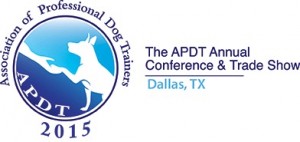
- Dr. Cynthia Otto
- Veronica Boutelle
- Gina Phairas
- Linda Case
- Charlene Woodward
- Sue Sternberg
- Sarah Fulcher
Check out this link for a complete list of Speakers – https://apdt.com/conference/speakers/
There will be live animal workshops where people get to actually work with guinea pigs in Dr. Roger Abrantes’ Scent Detection Workshop; Dr. Lore Haug’s IAABC Workshop – Advanced Behavior Techniques & Practices; working with dogs at the Dallas SPCA to learn new skills or hone their current skills in Teoti Anderson’s Desensitization & Counter Conditioning; Lisa McCluskey’s Troubleshooting Aggression/Anxiety; Sue Sternberg’s On Leash Dog-Dog Encounters. These Live Animal Workshops have a separate registration fee.
There are also short presentations throughout the day called APDT Shorts. Speakers will be talking about a wide variety of subjects from Aggression, Behaviorology, Business & Marketing, Dog Body Language, Euthanasia, Food, Stress, Science and so much more.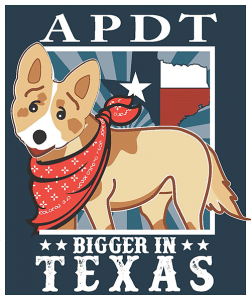
I’m suffering from “too much choice dilemma” since I don’t know who I want to see as yet. So I have to sit down, take a look at all the presentations and see which ones to attend that I can learn and benefit from the most. I really wish I could see ALL the speakers live.
But the good news is that if you want to get all the latest information and earn CEUs, you can buy their DVDs at https://apdt.com/conference/dvd/ or receive access to the Online Library at https://apdt.com/conference/streaming/
When you arrive at the conference hotel, the Sheraton Dallas Hotel, you need to check in at the Registration Desk to pick up your packet and you can ask them any questions.
Not only are the educational benefits diverse, but there are lots of opportunities to network, too:
- Scavenger Hunt
- Puppy Bingo
- Click-it With a Ticket
- Brochure and Business Card Contests
There is also the Trade Show and Exhibit Hall and I am going to enjoy browsing through and buying the books, DVDs, dog toys and other products which will be on show. Hope I don’t go over my 50 lb limit for my suitcase.
I know I am certainly looking forward to learning new things and meeting Facebook friends and people I have interviewed. Have I mentioned before that I am soooooooooo excited? LOL.
Get Dog Training Business Tips!
Receive valuable dog training business tips and resources every week! Subscribe to The Modern Dog Trainer now by submitting your name and email below.
[mc4wp_form]
![Review Of The Perfect Fit Harness]()
by Lisa | Sep 23, 2015 | Interviews
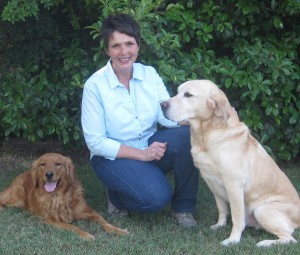
Karen with Cassidy (Golden Retriever) and Rock (Labrador Retriever); image via Karen Deeds, www.deedscanineconnection.com
Who Is Karen Deeds?
I do Facebook interviews with animal trainers, behaviourists and other professionals. I met up with Karen Deeds CDBC to chat about how she approaches aggression in dogs.
Karen Deeds became a Certified Dog Behavior Consultant, with the International Association of Animal Behavior Consultants, in October of 2013 and has taught at seminars and conferences in Texas, as well as other parts of the U.S. She is sought after for her expertise in training and behavior modification. In 2010, Karen received the Association of Pet Dog Trainers award for “Community Educator of the Year.” In 2013 she received the Dog Scouts of America “Good Scout Award,” recognizing her for her service to Dog Scouts.
You can find her –
Website – http://www.deedscanineconnection.com
Facebook – https://www.facebook.com/pages/CanineConnection/479935655150?pnref=lhc
My Interview With Karen About Dog Aggression
Lisa White: Thank you so much for joining us, Karen.
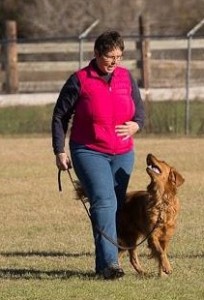
Karen with Cassidy competing early this year. Image via Karen Deeds, www.deedscanineconnection.com
Karen Deeds: Thank you for the invite!
LW: How did you get into training and behavior?
KD: It was in the early 90s when I was working with my dog on an out of sight down stay when I went behind the building and was met with an assailant. My dog came to my rescue after hearing me scream.
The next time he saw a person that was similar to the person who had assaulted me, he was aggressive. That was before I really knew what I was doing, but I brought the guy (who was a bather at the groom shop where I had taken him to be groomed), some hotdogs, and I started tossing my dog, Shoney, some hotdogs every time the kid came outside and he saw him.
Simple classical conditioning! I had taken Psych classes in junior college so I was familiar with some things!
I then started asking Shoney to perform various obedience tasks like Sit and Down in the presence of the trigger. Luckily I had a lot of good things going on with my dog in that he was a very stable boy and this was a single traumatic incident.
That is when I first realized there was a difference between training and behavior! At that time, most trainers were teaching more traditional methods that they used in competition even though that is not really what most pet dog owners needed.
LW: Indeed. So what methods do you use?
KD: I use positive reinforcement and utilize a variety of different protocols. I love to get a dog thinking so I love to free shape. It builds confidence by giving the dog the ability to make choices. I will use some luring, targeting, and of course shaping for basic skills with pet dog owners.
LW: Word is that you are well known for dealing with aggression. Can you tell us more about that?
KD: Yes, I do deal with a lot of aggression and reactivity. I guess it all started with Shoney. There was just such a need around here and I started to attend seminars, read books, and do ANYTHING I could to get more educated.
I also work with a lot of rescue organizations to help them assess dogs and that has led me to be pretty black and white about some of these cases.
LW: What do you mean by “black and white about some cases?”
KD: I think it is extremely important to understand the limitations of each case. I use a 15 point variable system to help determine what option is best for a client and the dog as well as how those variables influence the outcome.
It isn’t always about the dog – the owners and their environment play vital roles in the decision and my recommendations.
LW: What is that 15 point variable system?
KD: I’ll briefly outline them:
- Severity – I typically use the Ian Dunbar scale because it is simple for the owners to understand. The higher the number the worse the prognosis. There is also the location of the bite that I consider.
- Predictability – if the trigger is easy to predict it does make things easier to set up for behavior modification. Unpredictability is difficult, but a lot of times that unpredictability is only in the eye of the owner!
- Controllability – Being able to contain the dog for management purposes is vital as well. You can’t ALWAYS be working the program so the dog needs to be able to be contained safely. Whether it be in a crate, on a tether, in a muzzle, behind a baby gate or whatever.
- Previous training is a HUGE factor and it has become even more of a variable now that I see more dogs that have previously been trained with electronic collars or traditional ‘dominance’ methods. It diminishes trust and can often create a dog that can’t think for itself or has had the communication skills punished out of them.
- Trainability – A dog that is easy to motivate is easier to train. The lack of motivation can equal lack of desire to change behavior. Food is usually fastest, but play can be as strong or stronger for some dogs.
- Socialness – There are simply some dogs that do not have a desire to be social; either with strangers or other dogs. Unfortunately so many pet owner think their dog ‘needs’ to be social and all they really want is to be that little hermit dog that sleeps all day safely in the living room!

Canine Connection for the Real World Canine
- Children – This starts to get into the ‘people’ and environment factors which are, IMO, some of the most important. If there are children in the environment and they are a trigger then there needs to be huge consideration for what option is appropriate. There are only four options: Management (which usually fails at some point); Management and training and b-mod; Rehome; or Euthanize.
- Size of dog must be considered not only because a dog over 40 pounds can be harder to manage and contain, but perception from the public is also different. Not many people care if they get nipped by a Maltese (no offense to Maltese people!) but if it is a bigger dog then they do!
- Breed of dog – unfortunately it can matter! Because I do a lot of aggression people think I see Pit Bulls, Rottweilers and Dobermans, but my highest case loads are herding dogs, dogs under 25 pounds, and sporting breeds. Sometimes they appear to come in waves!
- Finances play a part too. An owner needs to be able to afford the medical work ups, the management systems, the training tools, and the help from a qualified trainer or behavior consultant or behaviorist. There is also the real possibility of litigation as well as medical costs if damage is done to a victim.
- Time – It is a valuable commodity and many people simply don’t have enough time to put into managing the dog let alone modifying its behavior and training them.
- Commitment – This can often be a lifelong commitment. There isn’t a quick fix and they must be prepared to go the distance.
- Compliance – Sometimes I know many of us in the field feel like marriage counselors! It is vital that everyone be on the same page in the household so that no one is undermining their success. Much like a kid that learns to go to mom when dad says no, it is confusing for the dog and creates unpredictability.
- Cognitive Dissonance – this has been something I really didn’t think would be an issue, but I have had several cases lately that one partner simply didn’t want to believe that their dog was afraid and not dominant! If they don’t buy into the science, I can’t help them!
- Duration – If the problem has been going on for a long time then the likelihood of changing it is diminished. The Matching Law is in play at that point. And some variables will outweigh the others. I have worked with clients with children in the home with a dog with a level 4 bite that I would never have worked with in a different home.
I find that the ‘people factors’ are the most vital. That is why I have had good luck with dog/dog issues doing board & trains. I can lay the foundation and then follow up with the clients.
LW: So if the owner doesn’t comply with your recommendations, then failure is the result.
KD: To a certain extent. It does depend on the severity at that point. In most cases enough improvement can be made that the owner can manage.
LW: At what point would/should one give up on an aggressive dog?
KD: I usually recommend that clients set a specific time before they reassess. 30-45-90 days, if at that point they simply can’t continue with the program, or there isn’t sufficient change, or there is another incident them we may have to come to another conclusion and different option.
LW: I find a lot of people/trainers seem to judge owners for their inability not to commit time to working with their aggressive dog. What are your feelings on this?
KD: I am not in their shoes. I will never judge them (at least not in front of them!), but seriously, I HAVE been there myself. I remember having to euthanize a dog I was fostering way back in the 80s because she had almost killed another one of my dogs and had then turned on my 3 year old son. I have been in the vet office holding many hands when they said goodbye to their family pet. I also have emails and get phone calls thanking me for allowing them to make such a decision that has freed up their lives and reduced stress in the household.
LW: It is a very stressful situation; you are on pins and needles all the time.
KD: Yes it is stressful for EVERYONE. Especially inter-housemate aggression or households with children.
LW: Unfortunately, time is up and we have to end this interview. Thank you so very much, Karen, for taking the time to chat with us.
KD: A very special thank you for considering me worthy of an interview!
Thank You
We’d like to extend a big thank you to Karen for letting us share this interview on The Modern Dog Trainer blog.
Get Dog Training Business Tips!
Receive valuable dog training business tips and resources every week! Subscribe to The Modern Dog Trainer now by submitting your name and email below.
[mc4wp_form]
![Review Of The Perfect Fit Harness]()
by Lisa | Jun 23, 2015 | Events, SPARCS
What Stresses Us?
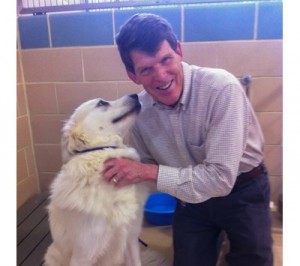 Types of Stressors
Types of Stressors
Psychological stressors
- Job interview
- Traffic
- Death in family
- Disease diagnosis
Physical stressors
Psychological stressors most highly activate the HPA system.
Stress Responses
- Sympathetic (adrenaline)
- Hypothalamic-pituitary-adrenal system
- Brain activity
- Behavior
Stressors elevate circulating levels of HPA
Cortisol level is (the best?) measure of stress:
- BUT, it is not a perfect measure
- Not all stressors clearly elevate cortisol
- Cortisol can increase without stress
- System can become dysregulated with prolonged exposure
Cortisol is a good measure of the effect of relatively short-term psychological stressors, when other factors affecting HPA activity are controlled.
Experimental Conditions
Handling control “Base”
- Alone home
- Alone novel
- Dog novel
- Person novel
- Threat
Dogs entering animal shelters are confronted with an array of psychological stressors (e.g., novelty, uncertainty, separation from attachment figures). On entering the shelter, cortisol is higher on Day 1 than in pets at home.
Why should high cortisol levels matter?
- Welfare of dogs
- Long-term effects on behavior
- Adoptability
- Potential health effects
White blood cells are elevated on 1st day in shelter and continue to rise.
Can human interaction reduce the cortisol response?
- Human interaction is a key factor for improving the welfare of dogs in shelters.
- Human-dog interaction can counteract stress.
- Human interaction prevents enhanced cortisol elevation.
Specific human interaction in the shelter reduces cortisol response to:
- additional stressor (venipuncture)
- additional stressor at a later time (novelty)
Presence of a human, regardless whether they ignore, pet or play with the dog, stress response is reduced for the shelter dogs. Suppressed immune systems from high CORT levels of dogs in shelters means there is a potential illness risk throughout entire shelter.
Shelter stresses:
- uncertainty
- loss of control
- social separation
- novelty
- threat
CORT levels differ depending on the kind of life the dog has and medical conditions.
Final Notes
Key ingredient: human interaction away from the main kennel area significantly reduces stress.
Relinquished dogs didn’t find human petting as reassuring (per cortisol tests) as strays.
Circulating levels of the primary stress hormone, cortisol, are about three times higher than observed in pet dogs sampled in their owner’s homes.
As little as 15 minutes of interaction between humans and dogs can reduce the circulating cortisol response.
Multiple sessions continued to produce effects, and dogs entering the shelter as strays appeared more susceptible to stress than dogs released by their owners.
![Review Of The Perfect Fit Harness]()
by Lisa | Jun 21, 2015 | Events, SPARCS
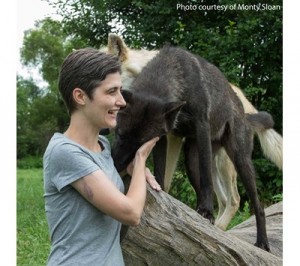
Kathryn Lord’s talk focused on the comparison of the reproductive differences between the dog – Canis familiaris and its other wild relatives in the genus Canis.
The genus Canis includes six incipient (inter-fertile) species: the dog (Canis familiaris), the wolves (Canis lupus and Canis simensis), coyotes (Canis latrans), jackals (Canis aureus) and dingoes (Canis dingo). There are two other emmbers of the genus, the black-backed jackals (Canis mesomelas) and the side-striped jackals (Canis adustrus).
There are many dogs on Earth. The worldwide population of the dog is unknown and difficult to calculate. One estimate is that the ratio is 1 dog to every 10 people = 700,000,000 dogs worldwide. Some say 1 billion dogs on the planet. That’s a lot of dogs.
However, only 17% dogs considered pets, 83% of 1 billion dogs are free living animals, not under human control or human care. They’re scavengers, un-medicated, they have control over own reproduction. They are found in dumps, their natural habitat.
Seasonality
Is the tendency for sexual activity – mating and parturition to occur during certain times of the year. Males and females within a species undergo biological changes to mate only during specific times to give birth, to coincide with food availability. Adaptive animals birth during food blooms.
Domestic dogs however are NOT seasonal. Females can come into estrus approximately every 7 months while males will mate whenever. Spreading pups out through the year decreases competition for food – no seasonality is preferable
Reproduction Age & Size
Simply a byproduct of size. You need to be shape of adult to reproduce.
Smaller animals reach maturity sooner, 8kg – 15kg, can reproduce within first year.
Larger animals, 30kg – 40kg, take longer to reach maturity, so 1 to 2 years old.
Free living dogs tend to be about the same size and shape, 13kg – 15kg
Mating Strategy
Pair Bonding: Mutual protection, care for young, mating strategies.
There are two kinds of monogomy: true and social and then there is polygamy.
True monogamy happens when female truly can’t raise all her offspring on her own. Parental care is necessary in wild canis: pups can’t survive until they can hunt for themselves. Wolf pups require 24/7 care, so dad has to hunt while mom nurses. Takes a long time to succeed
Wild canis tend to be monogamous. Not enough studies (except on Ethiopian wolf) to determine if social vs true monogamy. Some coyotes are truly monogamous.
Social monogamy: “don’t put all your eggs in one basket”. Ethiopian wolves socially monogamous.
Dump dogs: completely promiscuous and polygamous. No monogamy at all.
Regurgitation & Provisioning
Regurgitation very effective way to provide for offspring without theft from other animals
Regurgitation vs. provisioning because you can hide your food better. Chunk of meat can get stolen. Not if it’s in your tummy!
Bringing back meat can leave you open to scavengers stealing. Regurgitation is less able to be scavenged
Sibling Care
Help each other in good year, compete in bad years. Older siblings prioritized because closer to reproductive age.
It´s advantageous to help raising your brothers and sisters because they share some same genes as yours.
Wolves practice sibling care as well as parental care. Help your genes go forward…unless it’s a lean year, then steal!
Don’t want to share your already-eaten steak dinner? Put your face in the air and don’t let the pups lick you!
Dogs (Canis familiaris)
Dogs: indiscriminate breeders, lousy parents, opportunists.
Dogs outside human control developed improved parental skill – evolved for new environment
Dogs in dump don’t have to hunt. They can survive on their own long before adulthood. Less parental care needed
Living off human garbage is the ecological niche dogs, as a species, have adapted for – allowing them to reproduce & grow.
You can see more info here: http://www.researchgate.net/publication/232812626_Variation_in_reproductive_traits_of_members_of_the_genus_Canis_with_special_attention_to_the_domestic_dog_(Canis_familiaris)
![Review Of The Perfect Fit Harness]()
by Lisa | Jun 16, 2015 | Interviews

Chat Time Interview with Kevin Duggan CPDT
Chat Time Interviews are held on Facebook. During these interviews, I talk to experts about their areas of expertise. For this interview Kevin Duggan of All Dogs Go To Kevin LLC joined me to discuss blogging, the dog trainer certification process, and the ins and outs of running a successful dog training business.
Kevin Duggan is a Certified Professional Dog Trainer certified by the Certification Council for Professional Dog Trainers. He has been training professionally for 5 years. Kevin loves working with dogs and helping them mesh better into their homes. He does this by teaching the dog what we would like it to do, and reinforcing the behavior. This is also known as Positive Reinforcement. Kevin specializes in helping to build positive relationships between humans and their canine companions. He can help you with basic to advanced obedience as well as behavior modification. Along with helping people locally with his business, Kevin also writes for a variety of different websites. The most notable sites being Victoria Stilwell’s Positively.com as a Positively Contributor and the Dogington Post where he does an “ask the trainer” and writes articles.
Kevin has a popular blog of his own and creates educational viral videos to help spread the word about positive training. Don’t forget to subscribe to his YouTube Channel!
My Interview With Kevin
 Lisa G White: Welcome Kevin!
Lisa G White: Welcome Kevin!
Kevin Duggan: Thank you for having me!
Lisa G White: You are most welcome. I see you are a fellow CPDT-KA trainer. Why did you decide to take the CCPDT exam?
Kevin Duggan: Hi Lisa, when I first got into dog training I knew I wanted to do it for a living and researched where to go. I came across the CCPDT and saw how it is a nationally recognized certification council. I figured it was a great place to start.
Lisa G White: What areas of knowledge does the CPDT-KA exam cover and what can you expect from a trainer with this certification?
Kevin Duggan: Great question. What I really like about the exam is that it covered so many different things. In order to pass it you need to be knowledgeable in animal husbandry, ethology, instructional skills, and learning science techniques and application. It really covers a ton. It is a great place to get started for anyone that wants to become certified. Someone with a certification like me, in theory knows how dogs learn, why they do what they do (the dogs), and how and why they are doing what they are doing, (the trainer).
This certification says all that and much more, but doesn’t guarantee the methods used by the trainer. The majority of us are using up-to-date scientific methods that do not include pain or fear. With that being said there are some that are opting to use shock collars and other devices that cause pain and fear.
Lisa G White: Here is the link to the Certification Council for Professional Dog Trainers, Inc. with regards to info to this exam. What advice do you have for trainers preparing to take the CPDT-KA exam?
Kevin Duggan: My advice would be to find a certified trainer to mentor with. (*Remember to do your research about the trainer.) I mentored for about 2 years with 2 certified trainers. This is where I learned everything I needed to pass the test. I recommend sitting in on as many private consults and group classes as possible. Additionally, I recommend reading different books like Don’t Shoot the Dog, Excel-Erated Learning, Culture Clash to name a few. When it comes to being a dog trainer, knowledge is power. (not force.)
Lisa G White: How long have you been blogging for and why did you decide to do a blog?
Kevin Duggan: When I started my website I included a blog with it. I didn’t update it much. That was about 3 years ago. Within the past 2 years I’ve used it to spread the word about reward based training. I use it to give people free advice in the form of tips, articles, and videos. I do it for a couple other reasons as well. One, I enjoy writing things. I try to deliver information to people in a way that is easy to understand. I also recommend having a blog and keeping it updated for SEO in regards to bringing traffic to your site.
Lisa G White: What is your favourite article/video for your blog that you did?
Kevin Duggan: I don’t know if I could pick a favorite. Here is one that I like though. It puts emphasis on the fact that a lot of people are comfortable giving advice to people about their dogs when they have no business doing so. Here’s the article: Dog Training: Everyone is an Expert.
In regards to favorite videos: I don’t know if I can choose one. Here is my channel. I really enjoy everything about making videos, from coming up with the content, to shooting and editing. It’s all fun for me. And it works out great because it gives people help that otherwise couldn’t afford it.
Lisa G White: What challenges do you have with blogging?
Kevin Duggan: That’s a good question. I don’t have any issues with coming up with stuff to blog about. I just write what comes to me. One challenge is dealing with trolls. Those are the people who are looking to nitpick or just read the title of an article and comment without actually reading it. With that being said, I do not read the comments of any of my blogs. My advice to anyone that writes blogs is to not feed the trolls, they thrive on that.
Lisa G White: I take my hat off to you to do this, I’m a bit of a wuss. So many people always have something to say, to criticise. You cannot cover every single thing in a blog, only your own point of view. If you tried to do so, then it would become a bloody novel.
I see you are a guest blogger for Victoria Stillwell, how did that come about and how long have you been a guest blogger for her?
Kevin Duggan: Yes, I’ve recently started writing for the world-renowned Victoria Stilwell. They actually contacted me after reading my blog on my website. They liked what they saw and asked if I would like to be a Positively Expert. I have currently written 3 articles for her site over the past month. It has been an awesome opportunity/ experience to be able to reach even more people.
Lisa G White: WOW, what an honour, you must feel so pleased!
Kevin Duggan: If you would have told me a year ago that I would be writing for her I would have laughed at you. But hard work pays off.
Lisa G White: Indeed it does!
Kevin Duggan: Here is a link to my articles for Victoria.
Lisa G White: How did you come up with your business name? It is brilliant!
Kevin Duggan: My friend’s Mom actually came up with it. When I was searching for a business name she came up with All Dogs Go To Kevin LLC and I couldn’t pass it up.
Thank you. I was lucky to be named Kevin. All Dogs Go To Eric doesn’t quite have the same ring to it.
Lisa G White: LOL, so true. Today you posted on your FB page that in the past 3 months your website has moved up 4.5 million spots in the global rank. WOW, congratulations. Can you give us some advice / tips on what you have done to achieve this?
Kevin Duggan: My website has been something I’ve been working on for quite some time. When I started it I had it set up for information about me and my local business. Since then I’ve been turning it into a site that people can visit to get free advice in the form of blog posts and videos. That has helped. Additionally, writing for other popular sites like positively.com and dogingtonpost.com allows for more reach to people. It works out well. My advice to anyone that wants to do a site, keep updating it regularly with good info. Blogs are a great way to keep people coming back to your site. Videos are another great way. Keep your site easy to navigate. I see too many sites that are hard to navigate and unappealing to the eye. That will drive people away quickly.
Lisa G White: 4.5 million is a HUGE improvement though.
Kevin Duggan: It also comes down to page views on your site. Which is another reason to write blog posts. My blog posts reach on average between 500-1000 people. That equates to page views.
Lisa G White: That is fantastic Kevin! Last question from me – What is the biggest mistake you see trainers make when communicating with clients?
Kevin Duggan: I would say, there are a lot of “trainers” out there that have no business working with dogs. It is my job as a trainer to be as up-to-date as possible when it comes to scientifically sound training. There are lots of trainers out there today that are still giving people advice based off of outdated research that has been proven to be false. The biggest mistake those trainers make are giving outdated advice because they’re too stubborn to change their ways.
That being said, a mistake that scientifically sound trainers make is talking to science-e to everyday people. It is important to be able to communicate in a way that your clients will understand.
Lisa G White: That is so true Kevin. Ok the floor is now open for members to ask questions.
Facebook Group Member: I have a dog Babs she is adopted and can tell abused in her pass! Have been handling her and socializing her for over a year she just does not want to be social. She has tendency of being very aggressive. The same group of people have come and gone all of this time and she still attacks at times and other times she is OK – very unpredictable any advice? Babs is approx two years of age! At this point she is kennelled when company comes for she has bitten well quite a few so far.
Kevin Duggan: It really comes down to pairing the scary things with good stuff. The process is referred to as Counter Conditioning and Desensitization. My advice would be to do lots of research on CC/DS and start to implement it. That is the shortest answer I can give for your question. smile emoticon Sorry to hear about your situation.
Facebook Group Member: In your experience, how much floor space do you think is an adequate amount for a dog training/day care facility?
Kevin Duggan: I just opened my training center and it is just short of 1,000 square feet. It isn’t huge but gets the job done. I am able to do about 6 full size dogs in a basics class, 8 puppies, and for my reactive dogs I do 3 max in there. This gets the job done for me. If you go much smaller things can get chaotic and there just isn’t enough space in between dogs to get things accomplished.
Facebook Group Member: So nice to meet you Kevin. I am a CPDT-KA trainer as well. I have my own Facebook page which is growing. I write tips, information, education etc for dog owners and also cross post great articles from other trainers. Would you suggest a blog for someone like me? I haven’t jumped into that arena yet. I write new posts 3-5 days a week.
Kevin Duggan: I was doing most of my stuff on FB and decided to start sending people to my site. Overall, yes I would recommend starting off with even doing tips on your site and drawing people from FB to your site. Sometimes I do little tips on my Facebook page, but most often I am just doing teasers to get people to click a link and go to my site. I have started doing graphics recently as well. But the more traffic you can bring to your site, in theory the more business you can gain in clients.
Facebook Group Member: So is it your website or a blog?
Kevin Duggan: Both. My blog is a part of my website.
Facebook Group Member: Thanks so much. I’m going to go snoop now.
Lisa G White: Unfortunately, we have to end now, Kevin has to go watch football, and he is rooting for Green Bay to beat Seattle. Thank you so much Kevin for taking the time to chat with us!
Kevin Duggan: Thank you for having me. Thanks all for the questions.
Thank You
We’d like to extend a big thank you to Kevin for letting us share this interview on The Modern Dog Trainer blog. We look forward to reading and learning more from you! Also, thank you to Lisa for organizing and hosting the interviews.
Get Dog Training Business Tips!
Receive valuable dog training business tips and resources every week! Subscribe to The Modern Dog Trainer now by submitting your name and email below.
[mc4wp_form]











 Dr. Stephen Ledoux
Dr. Stephen Ledoux








 Types of Stressors
Types of Stressors

 Lisa G White: Welcome Kevin!
Lisa G White: Welcome Kevin!

